Organisation Behaviour Report: Individual and Team Dynamics at Ryanair
VerifiedAdded on 2023/01/19
|18
|5407
|90
Report
AI Summary
This report provides an in-depth analysis of organisational behaviour, utilizing Ryanair as a case study. It explores how organisational power, culture, and politics influence individual and team performance, examining different cultural models like Handy's and Hofstede's and power dynamics. The report also delves into motivation theories, contrasting process and content theories with an application of Vroom's expectancy theory. It further differentiates between effective and ineffective teams and concludes by applying organisational behaviour concepts and philosophies to the context of Ryanair, offering insights into fostering a positive and productive work environment. The report covers key aspects such as reward power, expert power, and the influence of positive and negative politics, providing a comprehensive understanding of how these factors affect organisational outcomes.
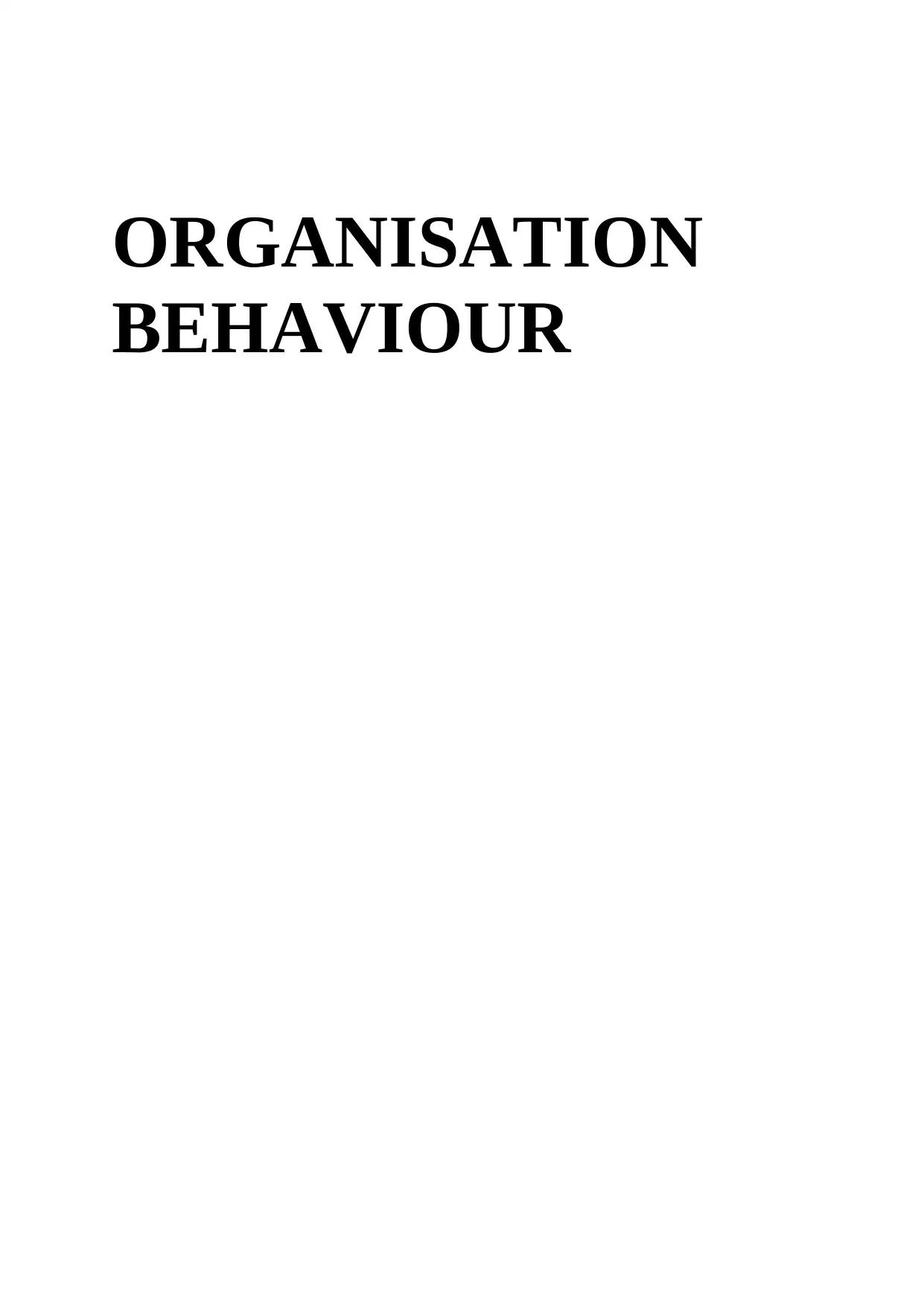
ORGANISATION
BEHAVIOUR
BEHAVIOUR
Paraphrase This Document
Need a fresh take? Get an instant paraphrase of this document with our AI Paraphraser
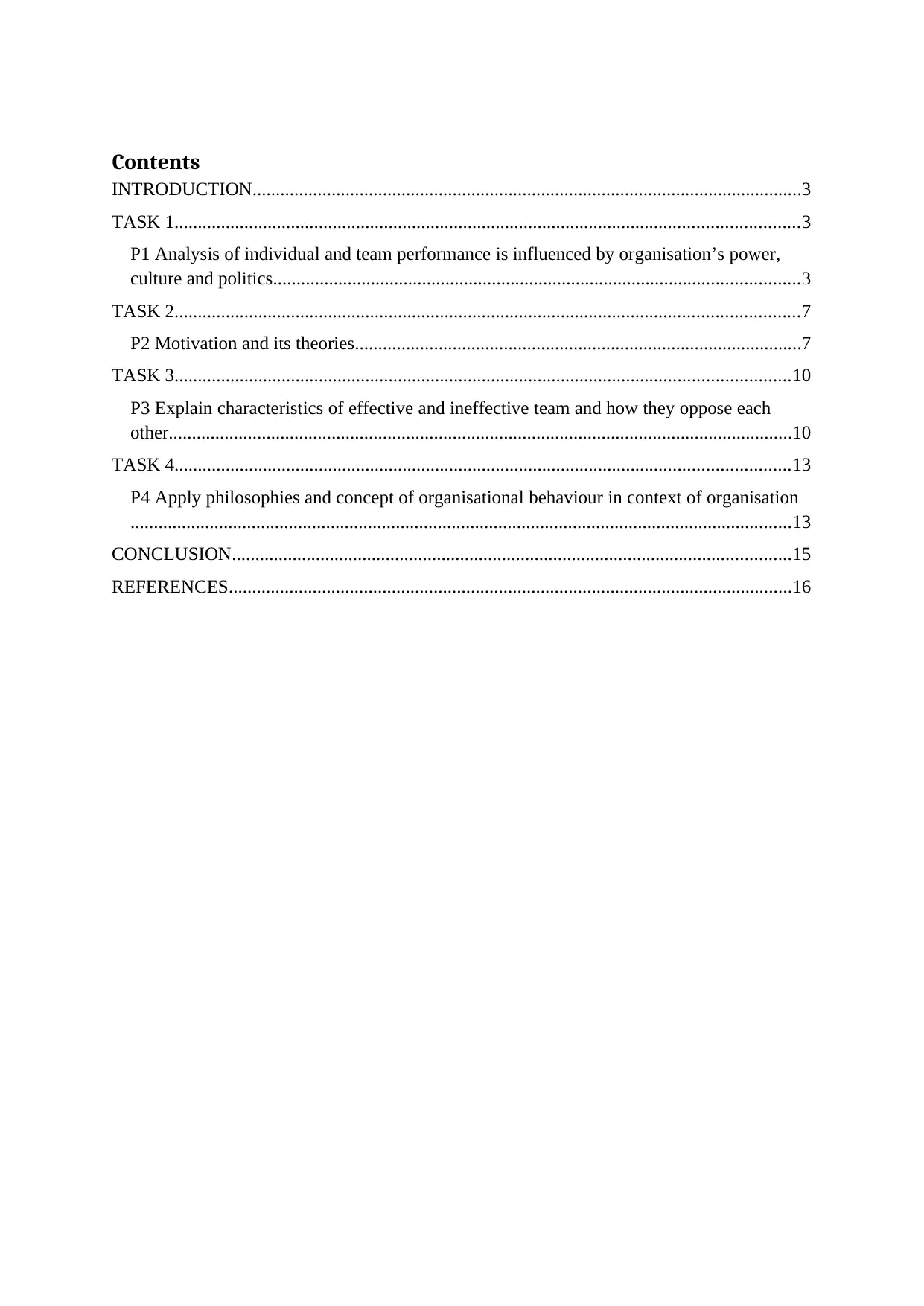
Contents
INTRODUCTION......................................................................................................................3
TASK 1......................................................................................................................................3
P1 Analysis of individual and team performance is influenced by organisation’s power,
culture and politics.................................................................................................................3
TASK 2......................................................................................................................................7
P2 Motivation and its theories................................................................................................7
TASK 3....................................................................................................................................10
P3 Explain characteristics of effective and ineffective team and how they oppose each
other......................................................................................................................................10
TASK 4....................................................................................................................................13
P4 Apply philosophies and concept of organisational behaviour in context of organisation
..............................................................................................................................................13
CONCLUSION........................................................................................................................15
REFERENCES.........................................................................................................................16
INTRODUCTION......................................................................................................................3
TASK 1......................................................................................................................................3
P1 Analysis of individual and team performance is influenced by organisation’s power,
culture and politics.................................................................................................................3
TASK 2......................................................................................................................................7
P2 Motivation and its theories................................................................................................7
TASK 3....................................................................................................................................10
P3 Explain characteristics of effective and ineffective team and how they oppose each
other......................................................................................................................................10
TASK 4....................................................................................................................................13
P4 Apply philosophies and concept of organisational behaviour in context of organisation
..............................................................................................................................................13
CONCLUSION........................................................................................................................15
REFERENCES.........................................................................................................................16
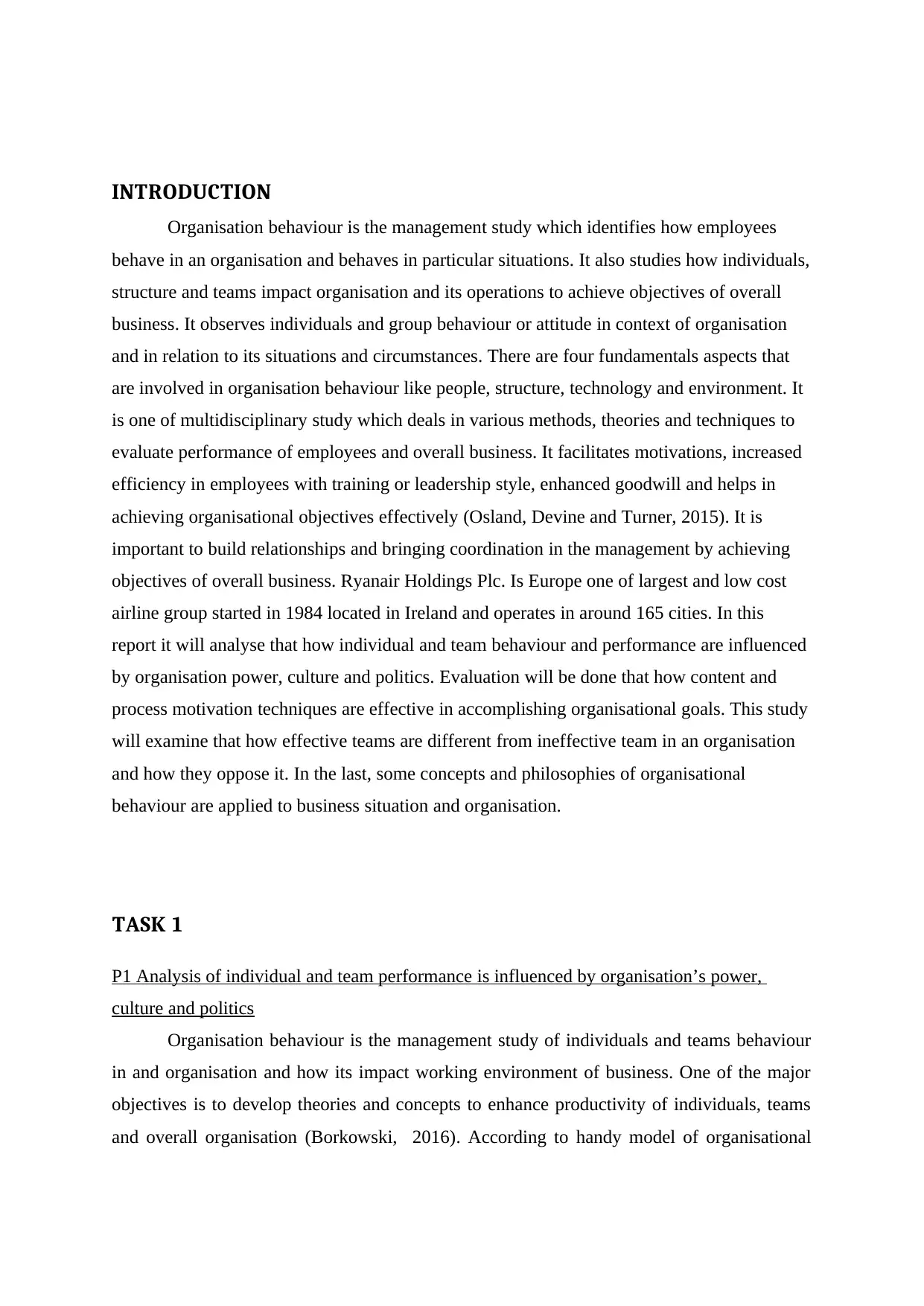
INTRODUCTION
Organisation behaviour is the management study which identifies how employees
behave in an organisation and behaves in particular situations. It also studies how individuals,
structure and teams impact organisation and its operations to achieve objectives of overall
business. It observes individuals and group behaviour or attitude in context of organisation
and in relation to its situations and circumstances. There are four fundamentals aspects that
are involved in organisation behaviour like people, structure, technology and environment. It
is one of multidisciplinary study which deals in various methods, theories and techniques to
evaluate performance of employees and overall business. It facilitates motivations, increased
efficiency in employees with training or leadership style, enhanced goodwill and helps in
achieving organisational objectives effectively (Osland, Devine and Turner, 2015). It is
important to build relationships and bringing coordination in the management by achieving
objectives of overall business. Ryanair Holdings Plc. Is Europe one of largest and low cost
airline group started in 1984 located in Ireland and operates in around 165 cities. In this
report it will analyse that how individual and team behaviour and performance are influenced
by organisation power, culture and politics. Evaluation will be done that how content and
process motivation techniques are effective in accomplishing organisational goals. This study
will examine that how effective teams are different from ineffective team in an organisation
and how they oppose it. In the last, some concepts and philosophies of organisational
behaviour are applied to business situation and organisation.
TASK 1
P1 Analysis of individual and team performance is influenced by organisation’s power,
culture and politics
Organisation behaviour is the management study of individuals and teams behaviour
in and organisation and how its impact working environment of business. One of the major
objectives is to develop theories and concepts to enhance productivity of individuals, teams
and overall organisation (Borkowski, 2016). According to handy model of organisational
Organisation behaviour is the management study which identifies how employees
behave in an organisation and behaves in particular situations. It also studies how individuals,
structure and teams impact organisation and its operations to achieve objectives of overall
business. It observes individuals and group behaviour or attitude in context of organisation
and in relation to its situations and circumstances. There are four fundamentals aspects that
are involved in organisation behaviour like people, structure, technology and environment. It
is one of multidisciplinary study which deals in various methods, theories and techniques to
evaluate performance of employees and overall business. It facilitates motivations, increased
efficiency in employees with training or leadership style, enhanced goodwill and helps in
achieving organisational objectives effectively (Osland, Devine and Turner, 2015). It is
important to build relationships and bringing coordination in the management by achieving
objectives of overall business. Ryanair Holdings Plc. Is Europe one of largest and low cost
airline group started in 1984 located in Ireland and operates in around 165 cities. In this
report it will analyse that how individual and team behaviour and performance are influenced
by organisation power, culture and politics. Evaluation will be done that how content and
process motivation techniques are effective in accomplishing organisational goals. This study
will examine that how effective teams are different from ineffective team in an organisation
and how they oppose it. In the last, some concepts and philosophies of organisational
behaviour are applied to business situation and organisation.
TASK 1
P1 Analysis of individual and team performance is influenced by organisation’s power,
culture and politics
Organisation behaviour is the management study of individuals and teams behaviour
in and organisation and how its impact working environment of business. One of the major
objectives is to develop theories and concepts to enhance productivity of individuals, teams
and overall organisation (Borkowski, 2016). According to handy model of organisational
⊘ This is a preview!⊘
Do you want full access?
Subscribe today to unlock all pages.

Trusted by 1+ million students worldwide
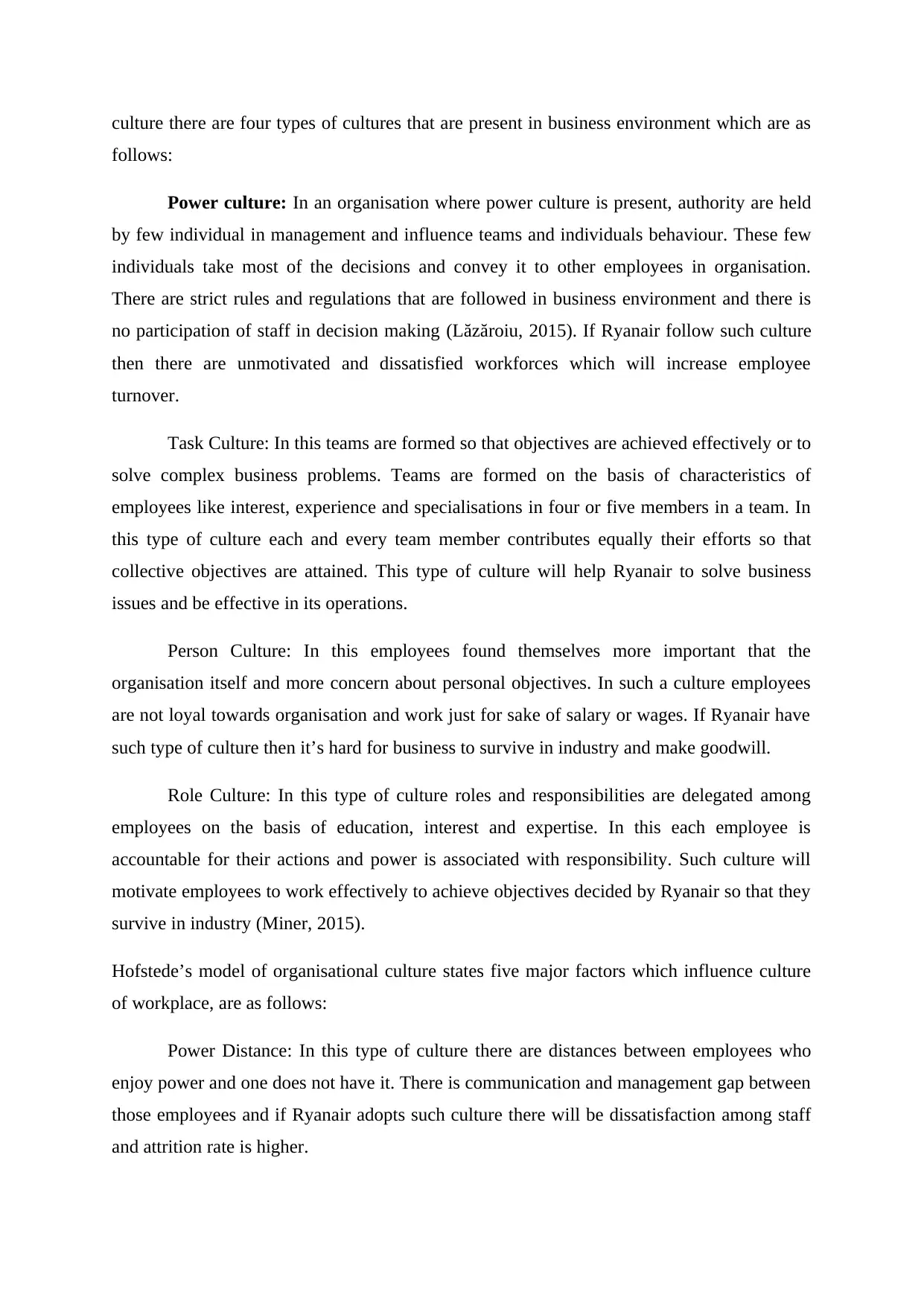
culture there are four types of cultures that are present in business environment which are as
follows:
Power culture: In an organisation where power culture is present, authority are held
by few individual in management and influence teams and individuals behaviour. These few
individuals take most of the decisions and convey it to other employees in organisation.
There are strict rules and regulations that are followed in business environment and there is
no participation of staff in decision making (Lăzăroiu, 2015). If Ryanair follow such culture
then there are unmotivated and dissatisfied workforces which will increase employee
turnover.
Task Culture: In this teams are formed so that objectives are achieved effectively or to
solve complex business problems. Teams are formed on the basis of characteristics of
employees like interest, experience and specialisations in four or five members in a team. In
this type of culture each and every team member contributes equally their efforts so that
collective objectives are attained. This type of culture will help Ryanair to solve business
issues and be effective in its operations.
Person Culture: In this employees found themselves more important that the
organisation itself and more concern about personal objectives. In such a culture employees
are not loyal towards organisation and work just for sake of salary or wages. If Ryanair have
such type of culture then it’s hard for business to survive in industry and make goodwill.
Role Culture: In this type of culture roles and responsibilities are delegated among
employees on the basis of education, interest and expertise. In this each employee is
accountable for their actions and power is associated with responsibility. Such culture will
motivate employees to work effectively to achieve objectives decided by Ryanair so that they
survive in industry (Miner, 2015).
Hofstede’s model of organisational culture states five major factors which influence culture
of workplace, are as follows:
Power Distance: In this type of culture there are distances between employees who
enjoy power and one does not have it. There is communication and management gap between
those employees and if Ryanair adopts such culture there will be dissatisfaction among staff
and attrition rate is higher.
follows:
Power culture: In an organisation where power culture is present, authority are held
by few individual in management and influence teams and individuals behaviour. These few
individuals take most of the decisions and convey it to other employees in organisation.
There are strict rules and regulations that are followed in business environment and there is
no participation of staff in decision making (Lăzăroiu, 2015). If Ryanair follow such culture
then there are unmotivated and dissatisfied workforces which will increase employee
turnover.
Task Culture: In this teams are formed so that objectives are achieved effectively or to
solve complex business problems. Teams are formed on the basis of characteristics of
employees like interest, experience and specialisations in four or five members in a team. In
this type of culture each and every team member contributes equally their efforts so that
collective objectives are attained. This type of culture will help Ryanair to solve business
issues and be effective in its operations.
Person Culture: In this employees found themselves more important that the
organisation itself and more concern about personal objectives. In such a culture employees
are not loyal towards organisation and work just for sake of salary or wages. If Ryanair have
such type of culture then it’s hard for business to survive in industry and make goodwill.
Role Culture: In this type of culture roles and responsibilities are delegated among
employees on the basis of education, interest and expertise. In this each employee is
accountable for their actions and power is associated with responsibility. Such culture will
motivate employees to work effectively to achieve objectives decided by Ryanair so that they
survive in industry (Miner, 2015).
Hofstede’s model of organisational culture states five major factors which influence culture
of workplace, are as follows:
Power Distance: In this type of culture there are distances between employees who
enjoy power and one does not have it. There is communication and management gap between
those employees and if Ryanair adopts such culture there will be dissatisfaction among staff
and attrition rate is higher.
Paraphrase This Document
Need a fresh take? Get an instant paraphrase of this document with our AI Paraphraser
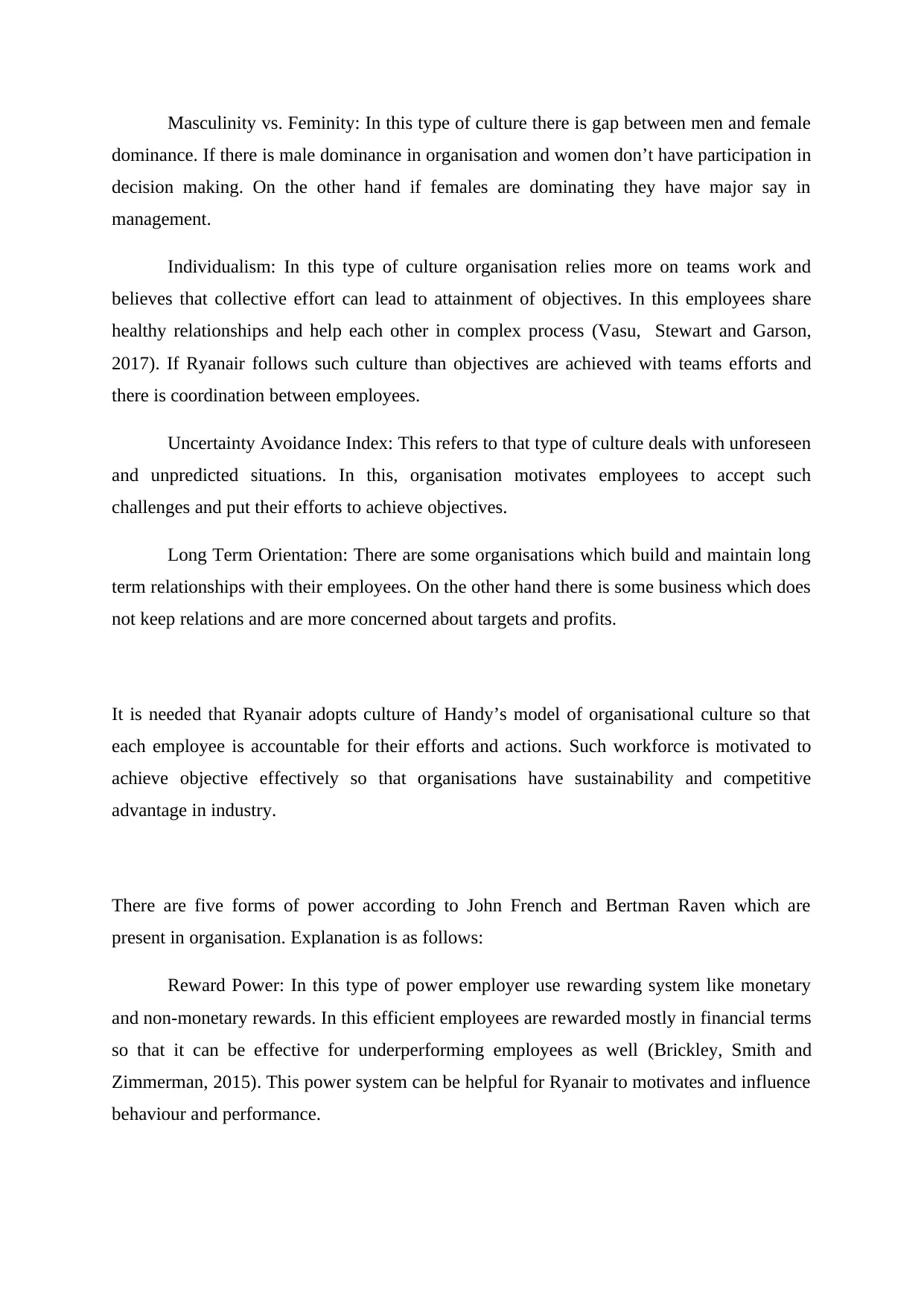
Masculinity vs. Feminity: In this type of culture there is gap between men and female
dominance. If there is male dominance in organisation and women don’t have participation in
decision making. On the other hand if females are dominating they have major say in
management.
Individualism: In this type of culture organisation relies more on teams work and
believes that collective effort can lead to attainment of objectives. In this employees share
healthy relationships and help each other in complex process (Vasu, Stewart and Garson,
2017). If Ryanair follows such culture than objectives are achieved with teams efforts and
there is coordination between employees.
Uncertainty Avoidance Index: This refers to that type of culture deals with unforeseen
and unpredicted situations. In this, organisation motivates employees to accept such
challenges and put their efforts to achieve objectives.
Long Term Orientation: There are some organisations which build and maintain long
term relationships with their employees. On the other hand there is some business which does
not keep relations and are more concerned about targets and profits.
It is needed that Ryanair adopts culture of Handy’s model of organisational culture so that
each employee is accountable for their efforts and actions. Such workforce is motivated to
achieve objective effectively so that organisations have sustainability and competitive
advantage in industry.
There are five forms of power according to John French and Bertman Raven which are
present in organisation. Explanation is as follows:
Reward Power: In this type of power employer use rewarding system like monetary
and non-monetary rewards. In this efficient employees are rewarded mostly in financial terms
so that it can be effective for underperforming employees as well (Brickley, Smith and
Zimmerman, 2015). This power system can be helpful for Ryanair to motivates and influence
behaviour and performance.
dominance. If there is male dominance in organisation and women don’t have participation in
decision making. On the other hand if females are dominating they have major say in
management.
Individualism: In this type of culture organisation relies more on teams work and
believes that collective effort can lead to attainment of objectives. In this employees share
healthy relationships and help each other in complex process (Vasu, Stewart and Garson,
2017). If Ryanair follows such culture than objectives are achieved with teams efforts and
there is coordination between employees.
Uncertainty Avoidance Index: This refers to that type of culture deals with unforeseen
and unpredicted situations. In this, organisation motivates employees to accept such
challenges and put their efforts to achieve objectives.
Long Term Orientation: There are some organisations which build and maintain long
term relationships with their employees. On the other hand there is some business which does
not keep relations and are more concerned about targets and profits.
It is needed that Ryanair adopts culture of Handy’s model of organisational culture so that
each employee is accountable for their efforts and actions. Such workforce is motivated to
achieve objective effectively so that organisations have sustainability and competitive
advantage in industry.
There are five forms of power according to John French and Bertman Raven which are
present in organisation. Explanation is as follows:
Reward Power: In this type of power employer use rewarding system like monetary
and non-monetary rewards. In this efficient employees are rewarded mostly in financial terms
so that it can be effective for underperforming employees as well (Brickley, Smith and
Zimmerman, 2015). This power system can be helpful for Ryanair to motivates and influence
behaviour and performance.
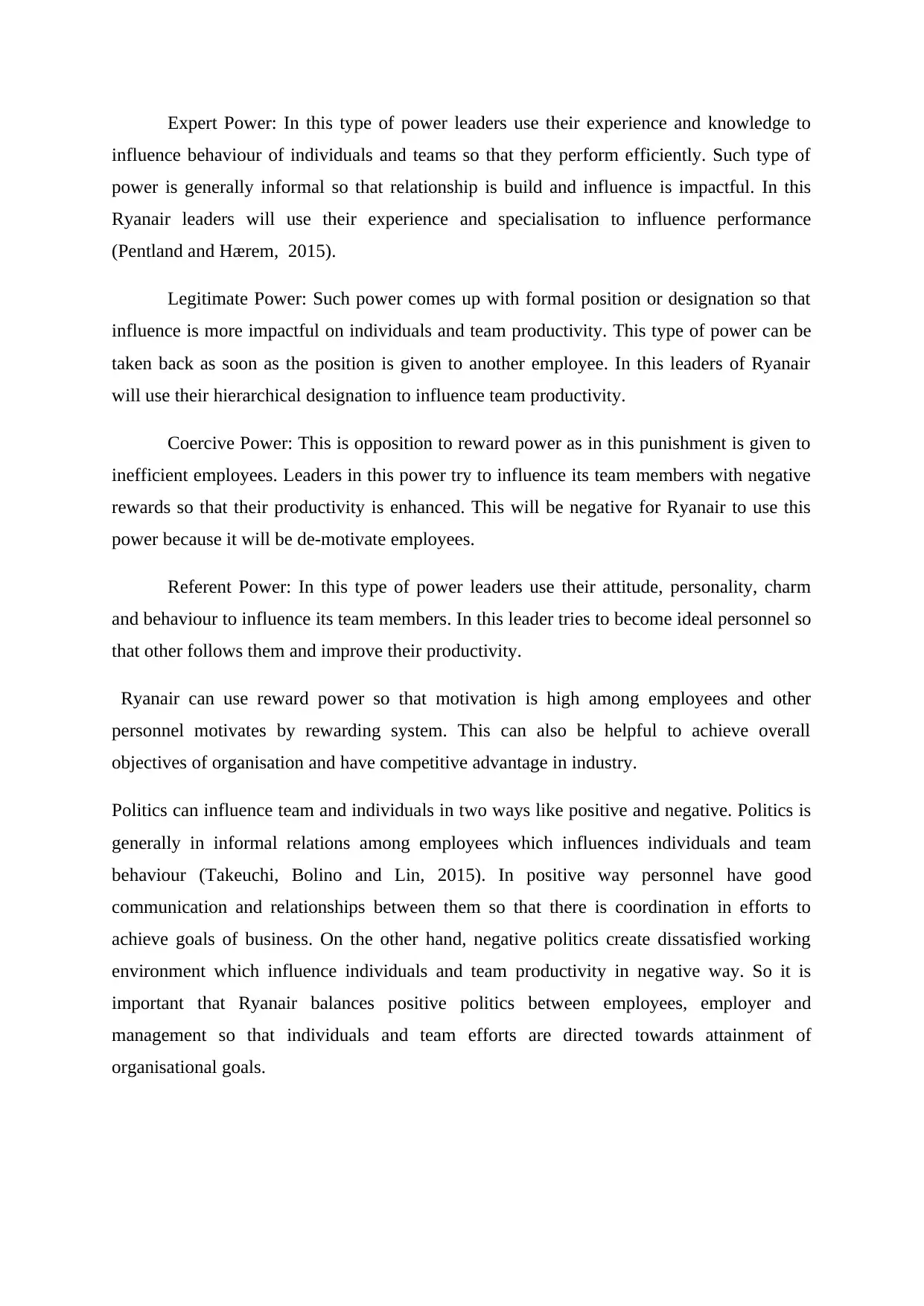
Expert Power: In this type of power leaders use their experience and knowledge to
influence behaviour of individuals and teams so that they perform efficiently. Such type of
power is generally informal so that relationship is build and influence is impactful. In this
Ryanair leaders will use their experience and specialisation to influence performance
(Pentland and Hærem, 2015).
Legitimate Power: Such power comes up with formal position or designation so that
influence is more impactful on individuals and team productivity. This type of power can be
taken back as soon as the position is given to another employee. In this leaders of Ryanair
will use their hierarchical designation to influence team productivity.
Coercive Power: This is opposition to reward power as in this punishment is given to
inefficient employees. Leaders in this power try to influence its team members with negative
rewards so that their productivity is enhanced. This will be negative for Ryanair to use this
power because it will be de-motivate employees.
Referent Power: In this type of power leaders use their attitude, personality, charm
and behaviour to influence its team members. In this leader tries to become ideal personnel so
that other follows them and improve their productivity.
Ryanair can use reward power so that motivation is high among employees and other
personnel motivates by rewarding system. This can also be helpful to achieve overall
objectives of organisation and have competitive advantage in industry.
Politics can influence team and individuals in two ways like positive and negative. Politics is
generally in informal relations among employees which influences individuals and team
behaviour (Takeuchi, Bolino and Lin, 2015). In positive way personnel have good
communication and relationships between them so that there is coordination in efforts to
achieve goals of business. On the other hand, negative politics create dissatisfied working
environment which influence individuals and team productivity in negative way. So it is
important that Ryanair balances positive politics between employees, employer and
management so that individuals and team efforts are directed towards attainment of
organisational goals.
influence behaviour of individuals and teams so that they perform efficiently. Such type of
power is generally informal so that relationship is build and influence is impactful. In this
Ryanair leaders will use their experience and specialisation to influence performance
(Pentland and Hærem, 2015).
Legitimate Power: Such power comes up with formal position or designation so that
influence is more impactful on individuals and team productivity. This type of power can be
taken back as soon as the position is given to another employee. In this leaders of Ryanair
will use their hierarchical designation to influence team productivity.
Coercive Power: This is opposition to reward power as in this punishment is given to
inefficient employees. Leaders in this power try to influence its team members with negative
rewards so that their productivity is enhanced. This will be negative for Ryanair to use this
power because it will be de-motivate employees.
Referent Power: In this type of power leaders use their attitude, personality, charm
and behaviour to influence its team members. In this leader tries to become ideal personnel so
that other follows them and improve their productivity.
Ryanair can use reward power so that motivation is high among employees and other
personnel motivates by rewarding system. This can also be helpful to achieve overall
objectives of organisation and have competitive advantage in industry.
Politics can influence team and individuals in two ways like positive and negative. Politics is
generally in informal relations among employees which influences individuals and team
behaviour (Takeuchi, Bolino and Lin, 2015). In positive way personnel have good
communication and relationships between them so that there is coordination in efforts to
achieve goals of business. On the other hand, negative politics create dissatisfied working
environment which influence individuals and team productivity in negative way. So it is
important that Ryanair balances positive politics between employees, employer and
management so that individuals and team efforts are directed towards attainment of
organisational goals.
⊘ This is a preview!⊘
Do you want full access?
Subscribe today to unlock all pages.

Trusted by 1+ million students worldwide
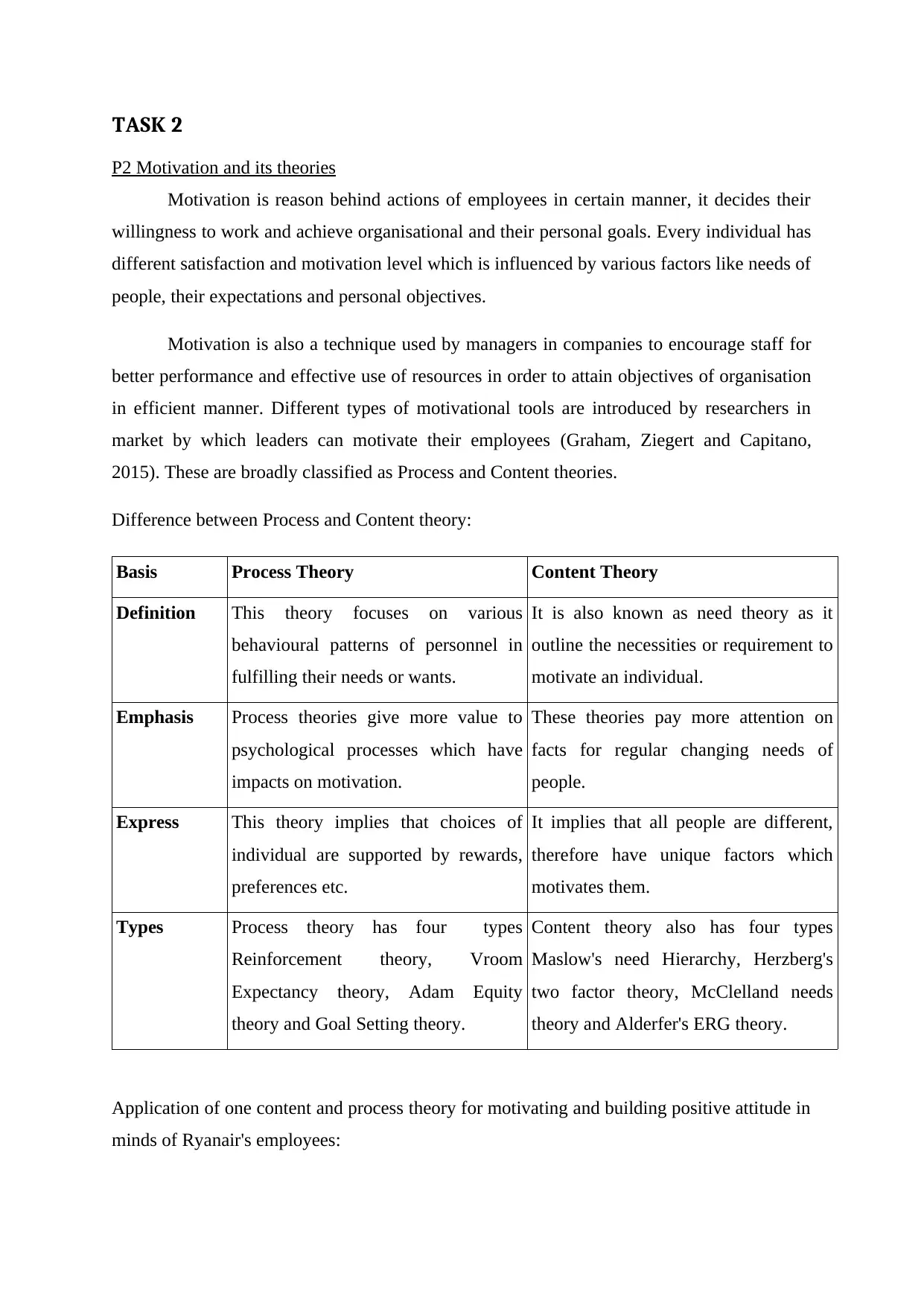
TASK 2
P2 Motivation and its theories
Motivation is reason behind actions of employees in certain manner, it decides their
willingness to work and achieve organisational and their personal goals. Every individual has
different satisfaction and motivation level which is influenced by various factors like needs of
people, their expectations and personal objectives.
Motivation is also a technique used by managers in companies to encourage staff for
better performance and effective use of resources in order to attain objectives of organisation
in efficient manner. Different types of motivational tools are introduced by researchers in
market by which leaders can motivate their employees (Graham, Ziegert and Capitano,
2015). These are broadly classified as Process and Content theories.
Difference between Process and Content theory:
Basis Process Theory Content Theory
Definition This theory focuses on various
behavioural patterns of personnel in
fulfilling their needs or wants.
It is also known as need theory as it
outline the necessities or requirement to
motivate an individual.
Emphasis Process theories give more value to
psychological processes which have
impacts on motivation.
These theories pay more attention on
facts for regular changing needs of
people.
Express This theory implies that choices of
individual are supported by rewards,
preferences etc.
It implies that all people are different,
therefore have unique factors which
motivates them.
Types Process theory has four types
Reinforcement theory, Vroom
Expectancy theory, Adam Equity
theory and Goal Setting theory.
Content theory also has four types
Maslow's need Hierarchy, Herzberg's
two factor theory, McClelland needs
theory and Alderfer's ERG theory.
Application of one content and process theory for motivating and building positive attitude in
minds of Ryanair's employees:
P2 Motivation and its theories
Motivation is reason behind actions of employees in certain manner, it decides their
willingness to work and achieve organisational and their personal goals. Every individual has
different satisfaction and motivation level which is influenced by various factors like needs of
people, their expectations and personal objectives.
Motivation is also a technique used by managers in companies to encourage staff for
better performance and effective use of resources in order to attain objectives of organisation
in efficient manner. Different types of motivational tools are introduced by researchers in
market by which leaders can motivate their employees (Graham, Ziegert and Capitano,
2015). These are broadly classified as Process and Content theories.
Difference between Process and Content theory:
Basis Process Theory Content Theory
Definition This theory focuses on various
behavioural patterns of personnel in
fulfilling their needs or wants.
It is also known as need theory as it
outline the necessities or requirement to
motivate an individual.
Emphasis Process theories give more value to
psychological processes which have
impacts on motivation.
These theories pay more attention on
facts for regular changing needs of
people.
Express This theory implies that choices of
individual are supported by rewards,
preferences etc.
It implies that all people are different,
therefore have unique factors which
motivates them.
Types Process theory has four types
Reinforcement theory, Vroom
Expectancy theory, Adam Equity
theory and Goal Setting theory.
Content theory also has four types
Maslow's need Hierarchy, Herzberg's
two factor theory, McClelland needs
theory and Alderfer's ERG theory.
Application of one content and process theory for motivating and building positive attitude in
minds of Ryanair's employees:
Paraphrase This Document
Need a fresh take? Get an instant paraphrase of this document with our AI Paraphraser
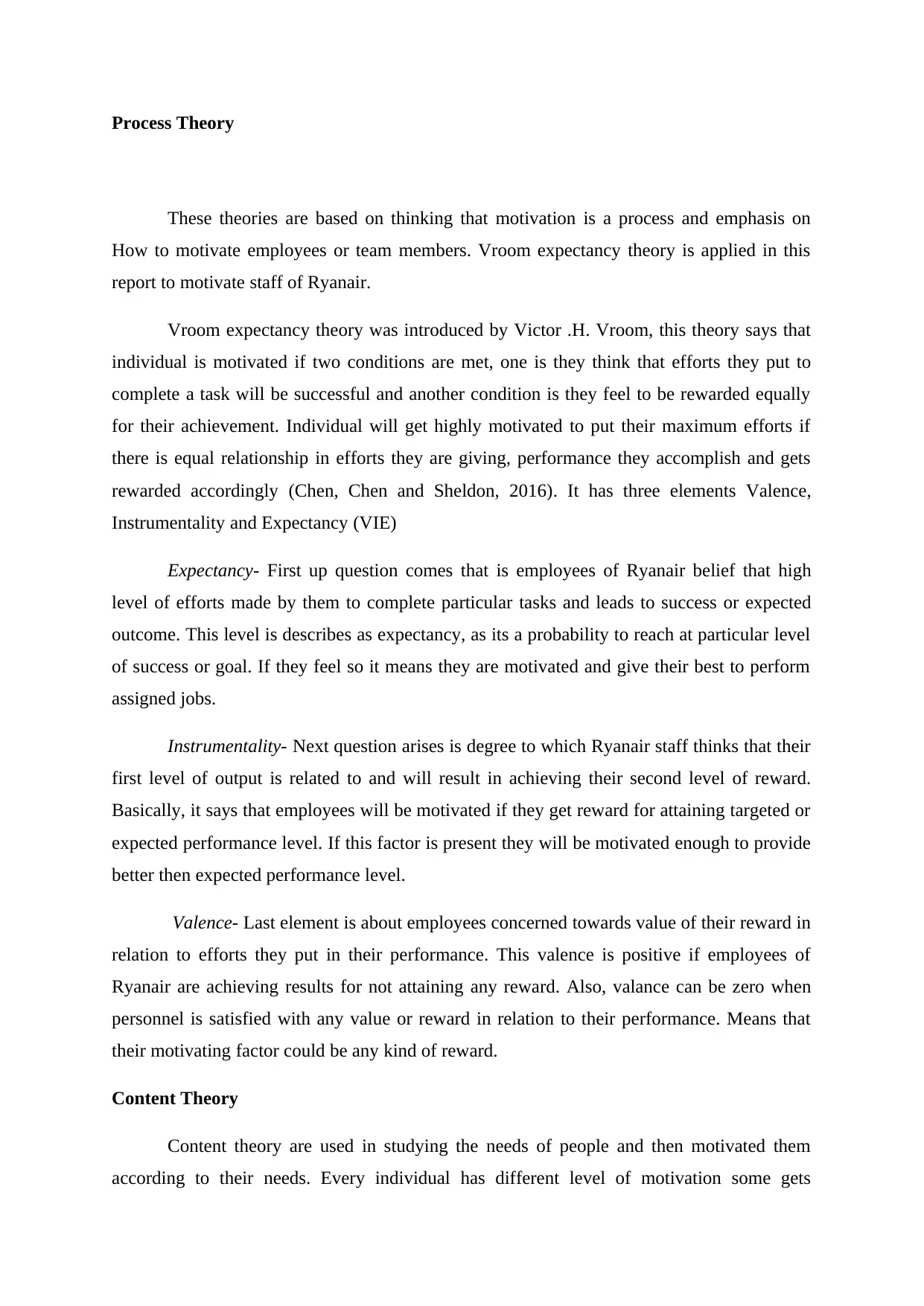
Process Theory
These theories are based on thinking that motivation is a process and emphasis on
How to motivate employees or team members. Vroom expectancy theory is applied in this
report to motivate staff of Ryanair.
Vroom expectancy theory was introduced by Victor .H. Vroom, this theory says that
individual is motivated if two conditions are met, one is they think that efforts they put to
complete a task will be successful and another condition is they feel to be rewarded equally
for their achievement. Individual will get highly motivated to put their maximum efforts if
there is equal relationship in efforts they are giving, performance they accomplish and gets
rewarded accordingly (Chen, Chen and Sheldon, 2016). It has three elements Valence,
Instrumentality and Expectancy (VIE)
Expectancy- First up question comes that is employees of Ryanair belief that high
level of efforts made by them to complete particular tasks and leads to success or expected
outcome. This level is describes as expectancy, as its a probability to reach at particular level
of success or goal. If they feel so it means they are motivated and give their best to perform
assigned jobs.
Instrumentality- Next question arises is degree to which Ryanair staff thinks that their
first level of output is related to and will result in achieving their second level of reward.
Basically, it says that employees will be motivated if they get reward for attaining targeted or
expected performance level. If this factor is present they will be motivated enough to provide
better then expected performance level.
Valence- Last element is about employees concerned towards value of their reward in
relation to efforts they put in their performance. This valence is positive if employees of
Ryanair are achieving results for not attaining any reward. Also, valance can be zero when
personnel is satisfied with any value or reward in relation to their performance. Means that
their motivating factor could be any kind of reward.
Content Theory
Content theory are used in studying the needs of people and then motivated them
according to their needs. Every individual has different level of motivation some gets
These theories are based on thinking that motivation is a process and emphasis on
How to motivate employees or team members. Vroom expectancy theory is applied in this
report to motivate staff of Ryanair.
Vroom expectancy theory was introduced by Victor .H. Vroom, this theory says that
individual is motivated if two conditions are met, one is they think that efforts they put to
complete a task will be successful and another condition is they feel to be rewarded equally
for their achievement. Individual will get highly motivated to put their maximum efforts if
there is equal relationship in efforts they are giving, performance they accomplish and gets
rewarded accordingly (Chen, Chen and Sheldon, 2016). It has three elements Valence,
Instrumentality and Expectancy (VIE)
Expectancy- First up question comes that is employees of Ryanair belief that high
level of efforts made by them to complete particular tasks and leads to success or expected
outcome. This level is describes as expectancy, as its a probability to reach at particular level
of success or goal. If they feel so it means they are motivated and give their best to perform
assigned jobs.
Instrumentality- Next question arises is degree to which Ryanair staff thinks that their
first level of output is related to and will result in achieving their second level of reward.
Basically, it says that employees will be motivated if they get reward for attaining targeted or
expected performance level. If this factor is present they will be motivated enough to provide
better then expected performance level.
Valence- Last element is about employees concerned towards value of their reward in
relation to efforts they put in their performance. This valence is positive if employees of
Ryanair are achieving results for not attaining any reward. Also, valance can be zero when
personnel is satisfied with any value or reward in relation to their performance. Means that
their motivating factor could be any kind of reward.
Content Theory
Content theory are used in studying the needs of people and then motivated them
according to their needs. Every individual has different level of motivation some gets
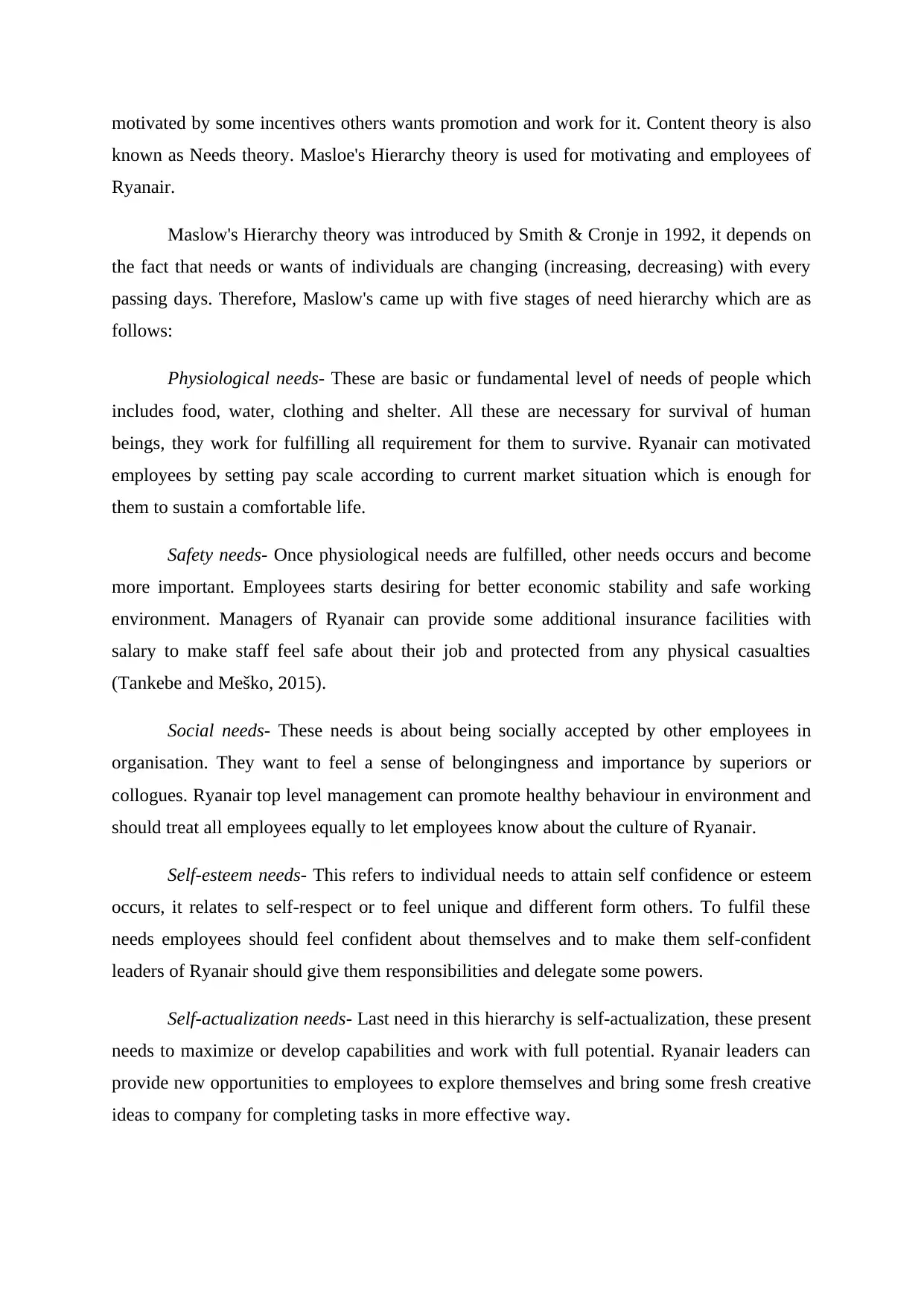
motivated by some incentives others wants promotion and work for it. Content theory is also
known as Needs theory. Masloe's Hierarchy theory is used for motivating and employees of
Ryanair.
Maslow's Hierarchy theory was introduced by Smith & Cronje in 1992, it depends on
the fact that needs or wants of individuals are changing (increasing, decreasing) with every
passing days. Therefore, Maslow's came up with five stages of need hierarchy which are as
follows:
Physiological needs- These are basic or fundamental level of needs of people which
includes food, water, clothing and shelter. All these are necessary for survival of human
beings, they work for fulfilling all requirement for them to survive. Ryanair can motivated
employees by setting pay scale according to current market situation which is enough for
them to sustain a comfortable life.
Safety needs- Once physiological needs are fulfilled, other needs occurs and become
more important. Employees starts desiring for better economic stability and safe working
environment. Managers of Ryanair can provide some additional insurance facilities with
salary to make staff feel safe about their job and protected from any physical casualties
(Tankebe and Meško, 2015).
Social needs- These needs is about being socially accepted by other employees in
organisation. They want to feel a sense of belongingness and importance by superiors or
collogues. Ryanair top level management can promote healthy behaviour in environment and
should treat all employees equally to let employees know about the culture of Ryanair.
Self-esteem needs- This refers to individual needs to attain self confidence or esteem
occurs, it relates to self-respect or to feel unique and different form others. To fulfil these
needs employees should feel confident about themselves and to make them self-confident
leaders of Ryanair should give them responsibilities and delegate some powers.
Self-actualization needs- Last need in this hierarchy is self-actualization, these present
needs to maximize or develop capabilities and work with full potential. Ryanair leaders can
provide new opportunities to employees to explore themselves and bring some fresh creative
ideas to company for completing tasks in more effective way.
known as Needs theory. Masloe's Hierarchy theory is used for motivating and employees of
Ryanair.
Maslow's Hierarchy theory was introduced by Smith & Cronje in 1992, it depends on
the fact that needs or wants of individuals are changing (increasing, decreasing) with every
passing days. Therefore, Maslow's came up with five stages of need hierarchy which are as
follows:
Physiological needs- These are basic or fundamental level of needs of people which
includes food, water, clothing and shelter. All these are necessary for survival of human
beings, they work for fulfilling all requirement for them to survive. Ryanair can motivated
employees by setting pay scale according to current market situation which is enough for
them to sustain a comfortable life.
Safety needs- Once physiological needs are fulfilled, other needs occurs and become
more important. Employees starts desiring for better economic stability and safe working
environment. Managers of Ryanair can provide some additional insurance facilities with
salary to make staff feel safe about their job and protected from any physical casualties
(Tankebe and Meško, 2015).
Social needs- These needs is about being socially accepted by other employees in
organisation. They want to feel a sense of belongingness and importance by superiors or
collogues. Ryanair top level management can promote healthy behaviour in environment and
should treat all employees equally to let employees know about the culture of Ryanair.
Self-esteem needs- This refers to individual needs to attain self confidence or esteem
occurs, it relates to self-respect or to feel unique and different form others. To fulfil these
needs employees should feel confident about themselves and to make them self-confident
leaders of Ryanair should give them responsibilities and delegate some powers.
Self-actualization needs- Last need in this hierarchy is self-actualization, these present
needs to maximize or develop capabilities and work with full potential. Ryanair leaders can
provide new opportunities to employees to explore themselves and bring some fresh creative
ideas to company for completing tasks in more effective way.
⊘ This is a preview!⊘
Do you want full access?
Subscribe today to unlock all pages.

Trusted by 1+ million students worldwide
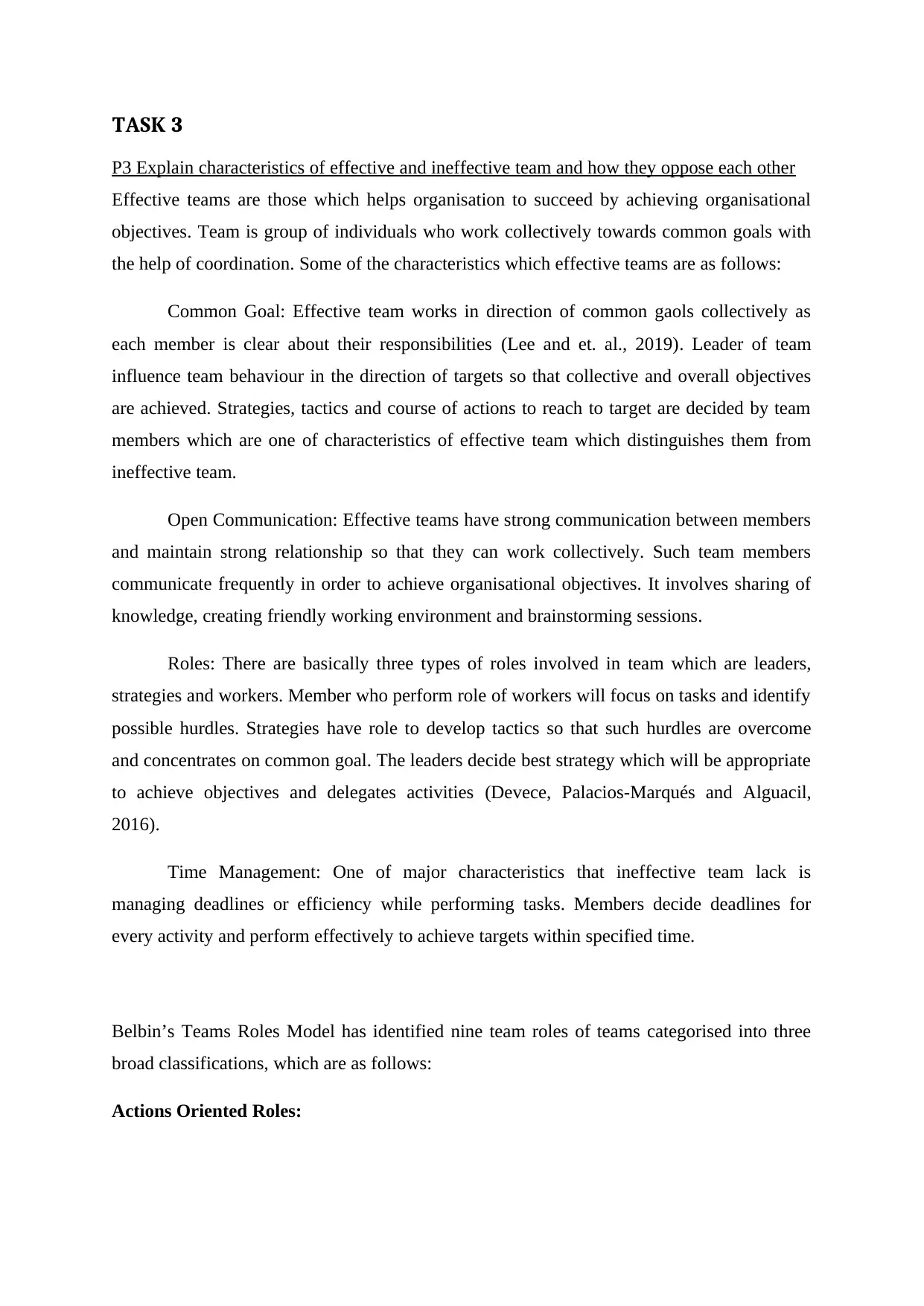
TASK 3
P3 Explain characteristics of effective and ineffective team and how they oppose each other
Effective teams are those which helps organisation to succeed by achieving organisational
objectives. Team is group of individuals who work collectively towards common goals with
the help of coordination. Some of the characteristics which effective teams are as follows:
Common Goal: Effective team works in direction of common gaols collectively as
each member is clear about their responsibilities (Lee and et. al., 2019). Leader of team
influence team behaviour in the direction of targets so that collective and overall objectives
are achieved. Strategies, tactics and course of actions to reach to target are decided by team
members which are one of characteristics of effective team which distinguishes them from
ineffective team.
Open Communication: Effective teams have strong communication between members
and maintain strong relationship so that they can work collectively. Such team members
communicate frequently in order to achieve organisational objectives. It involves sharing of
knowledge, creating friendly working environment and brainstorming sessions.
Roles: There are basically three types of roles involved in team which are leaders,
strategies and workers. Member who perform role of workers will focus on tasks and identify
possible hurdles. Strategies have role to develop tactics so that such hurdles are overcome
and concentrates on common goal. The leaders decide best strategy which will be appropriate
to achieve objectives and delegates activities (Devece, Palacios-Marqués and Alguacil,
2016).
Time Management: One of major characteristics that ineffective team lack is
managing deadlines or efficiency while performing tasks. Members decide deadlines for
every activity and perform effectively to achieve targets within specified time.
Belbin’s Teams Roles Model has identified nine team roles of teams categorised into three
broad classifications, which are as follows:
Actions Oriented Roles:
P3 Explain characteristics of effective and ineffective team and how they oppose each other
Effective teams are those which helps organisation to succeed by achieving organisational
objectives. Team is group of individuals who work collectively towards common goals with
the help of coordination. Some of the characteristics which effective teams are as follows:
Common Goal: Effective team works in direction of common gaols collectively as
each member is clear about their responsibilities (Lee and et. al., 2019). Leader of team
influence team behaviour in the direction of targets so that collective and overall objectives
are achieved. Strategies, tactics and course of actions to reach to target are decided by team
members which are one of characteristics of effective team which distinguishes them from
ineffective team.
Open Communication: Effective teams have strong communication between members
and maintain strong relationship so that they can work collectively. Such team members
communicate frequently in order to achieve organisational objectives. It involves sharing of
knowledge, creating friendly working environment and brainstorming sessions.
Roles: There are basically three types of roles involved in team which are leaders,
strategies and workers. Member who perform role of workers will focus on tasks and identify
possible hurdles. Strategies have role to develop tactics so that such hurdles are overcome
and concentrates on common goal. The leaders decide best strategy which will be appropriate
to achieve objectives and delegates activities (Devece, Palacios-Marqués and Alguacil,
2016).
Time Management: One of major characteristics that ineffective team lack is
managing deadlines or efficiency while performing tasks. Members decide deadlines for
every activity and perform effectively to achieve targets within specified time.
Belbin’s Teams Roles Model has identified nine team roles of teams categorised into three
broad classifications, which are as follows:
Actions Oriented Roles:
Paraphrase This Document
Need a fresh take? Get an instant paraphrase of this document with our AI Paraphraser
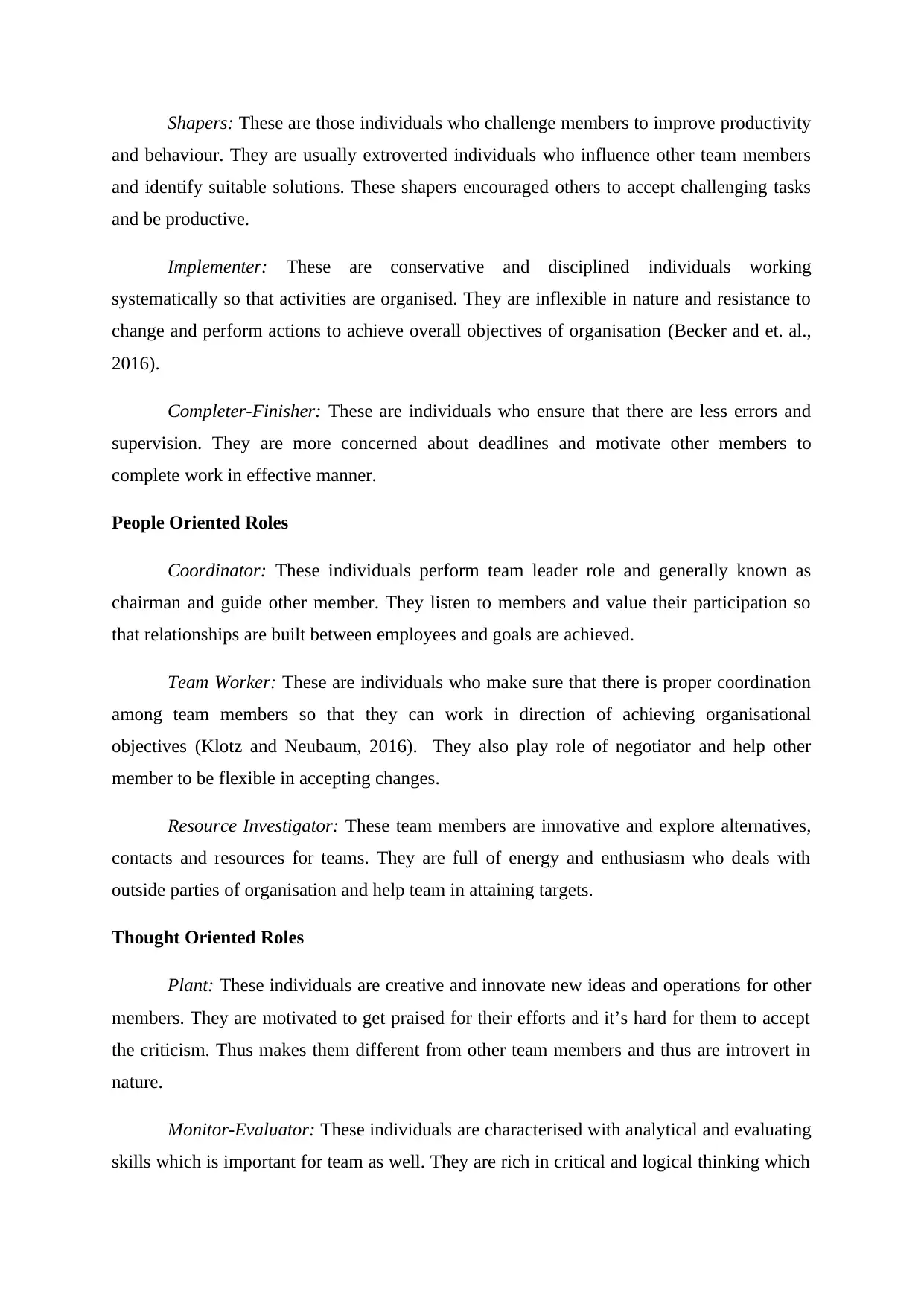
Shapers: These are those individuals who challenge members to improve productivity
and behaviour. They are usually extroverted individuals who influence other team members
and identify suitable solutions. These shapers encouraged others to accept challenging tasks
and be productive.
Implementer: These are conservative and disciplined individuals working
systematically so that activities are organised. They are inflexible in nature and resistance to
change and perform actions to achieve overall objectives of organisation (Becker and et. al.,
2016).
Completer-Finisher: These are individuals who ensure that there are less errors and
supervision. They are more concerned about deadlines and motivate other members to
complete work in effective manner.
People Oriented Roles
Coordinator: These individuals perform team leader role and generally known as
chairman and guide other member. They listen to members and value their participation so
that relationships are built between employees and goals are achieved.
Team Worker: These are individuals who make sure that there is proper coordination
among team members so that they can work in direction of achieving organisational
objectives (Klotz and Neubaum, 2016). They also play role of negotiator and help other
member to be flexible in accepting changes.
Resource Investigator: These team members are innovative and explore alternatives,
contacts and resources for teams. They are full of energy and enthusiasm who deals with
outside parties of organisation and help team in attaining targets.
Thought Oriented Roles
Plant: These individuals are creative and innovate new ideas and operations for other
members. They are motivated to get praised for their efforts and it’s hard for them to accept
the criticism. Thus makes them different from other team members and thus are introvert in
nature.
Monitor-Evaluator: These individuals are characterised with analytical and evaluating
skills which is important for team as well. They are rich in critical and logical thinking which
and behaviour. They are usually extroverted individuals who influence other team members
and identify suitable solutions. These shapers encouraged others to accept challenging tasks
and be productive.
Implementer: These are conservative and disciplined individuals working
systematically so that activities are organised. They are inflexible in nature and resistance to
change and perform actions to achieve overall objectives of organisation (Becker and et. al.,
2016).
Completer-Finisher: These are individuals who ensure that there are less errors and
supervision. They are more concerned about deadlines and motivate other members to
complete work in effective manner.
People Oriented Roles
Coordinator: These individuals perform team leader role and generally known as
chairman and guide other member. They listen to members and value their participation so
that relationships are built between employees and goals are achieved.
Team Worker: These are individuals who make sure that there is proper coordination
among team members so that they can work in direction of achieving organisational
objectives (Klotz and Neubaum, 2016). They also play role of negotiator and help other
member to be flexible in accepting changes.
Resource Investigator: These team members are innovative and explore alternatives,
contacts and resources for teams. They are full of energy and enthusiasm who deals with
outside parties of organisation and help team in attaining targets.
Thought Oriented Roles
Plant: These individuals are creative and innovate new ideas and operations for other
members. They are motivated to get praised for their efforts and it’s hard for them to accept
the criticism. Thus makes them different from other team members and thus are introvert in
nature.
Monitor-Evaluator: These individuals are characterised with analytical and evaluating
skills which is important for team as well. They are rich in critical and logical thinking which
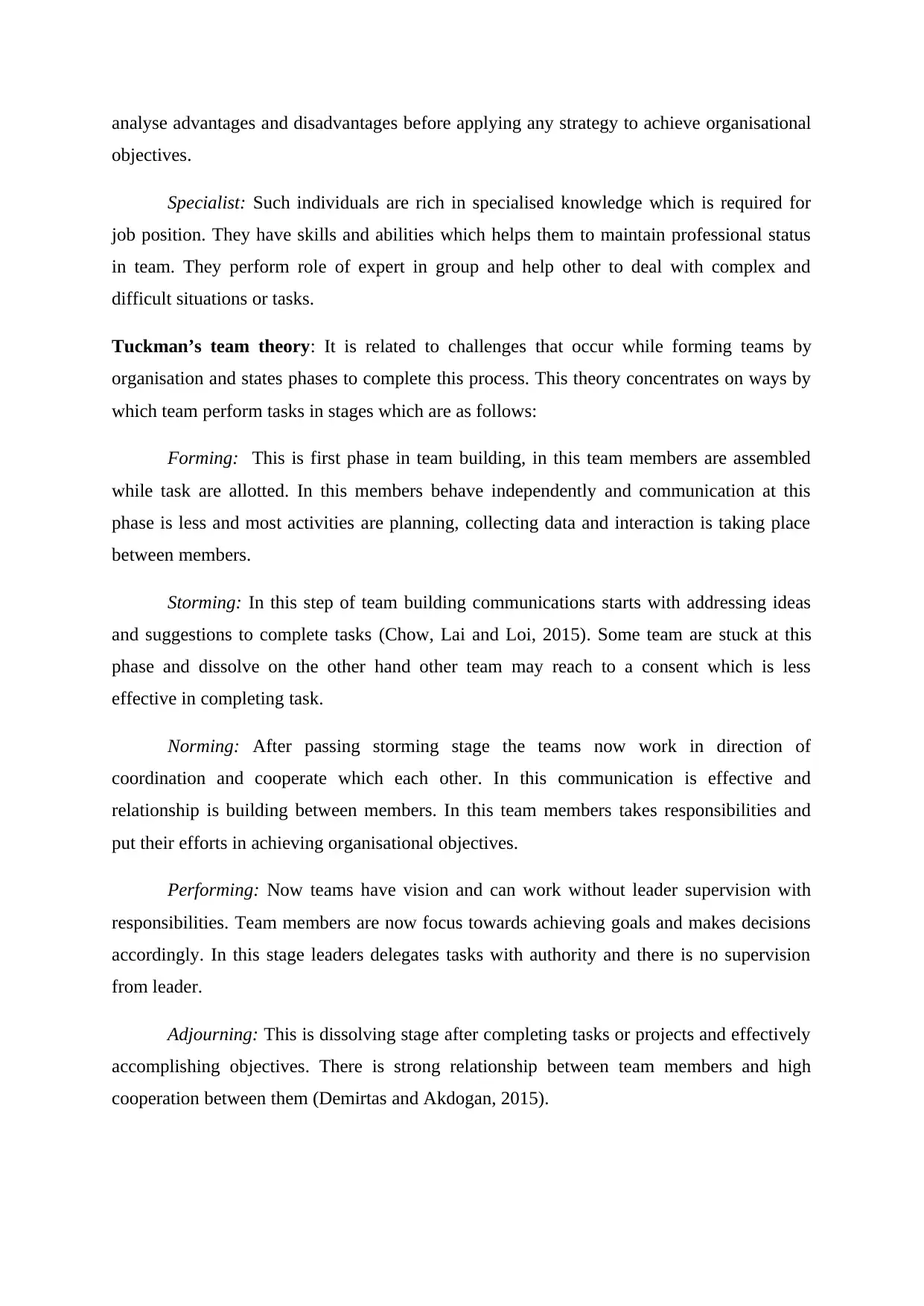
analyse advantages and disadvantages before applying any strategy to achieve organisational
objectives.
Specialist: Such individuals are rich in specialised knowledge which is required for
job position. They have skills and abilities which helps them to maintain professional status
in team. They perform role of expert in group and help other to deal with complex and
difficult situations or tasks.
Tuckman’s team theory: It is related to challenges that occur while forming teams by
organisation and states phases to complete this process. This theory concentrates on ways by
which team perform tasks in stages which are as follows:
Forming: This is first phase in team building, in this team members are assembled
while task are allotted. In this members behave independently and communication at this
phase is less and most activities are planning, collecting data and interaction is taking place
between members.
Storming: In this step of team building communications starts with addressing ideas
and suggestions to complete tasks (Chow, Lai and Loi, 2015). Some team are stuck at this
phase and dissolve on the other hand other team may reach to a consent which is less
effective in completing task.
Norming: After passing storming stage the teams now work in direction of
coordination and cooperate which each other. In this communication is effective and
relationship is building between members. In this team members takes responsibilities and
put their efforts in achieving organisational objectives.
Performing: Now teams have vision and can work without leader supervision with
responsibilities. Team members are now focus towards achieving goals and makes decisions
accordingly. In this stage leaders delegates tasks with authority and there is no supervision
from leader.
Adjourning: This is dissolving stage after completing tasks or projects and effectively
accomplishing objectives. There is strong relationship between team members and high
cooperation between them (Demirtas and Akdogan, 2015).
objectives.
Specialist: Such individuals are rich in specialised knowledge which is required for
job position. They have skills and abilities which helps them to maintain professional status
in team. They perform role of expert in group and help other to deal with complex and
difficult situations or tasks.
Tuckman’s team theory: It is related to challenges that occur while forming teams by
organisation and states phases to complete this process. This theory concentrates on ways by
which team perform tasks in stages which are as follows:
Forming: This is first phase in team building, in this team members are assembled
while task are allotted. In this members behave independently and communication at this
phase is less and most activities are planning, collecting data and interaction is taking place
between members.
Storming: In this step of team building communications starts with addressing ideas
and suggestions to complete tasks (Chow, Lai and Loi, 2015). Some team are stuck at this
phase and dissolve on the other hand other team may reach to a consent which is less
effective in completing task.
Norming: After passing storming stage the teams now work in direction of
coordination and cooperate which each other. In this communication is effective and
relationship is building between members. In this team members takes responsibilities and
put their efforts in achieving organisational objectives.
Performing: Now teams have vision and can work without leader supervision with
responsibilities. Team members are now focus towards achieving goals and makes decisions
accordingly. In this stage leaders delegates tasks with authority and there is no supervision
from leader.
Adjourning: This is dissolving stage after completing tasks or projects and effectively
accomplishing objectives. There is strong relationship between team members and high
cooperation between them (Demirtas and Akdogan, 2015).
⊘ This is a preview!⊘
Do you want full access?
Subscribe today to unlock all pages.

Trusted by 1+ million students worldwide
1 out of 18
Related Documents
Your All-in-One AI-Powered Toolkit for Academic Success.
+13062052269
info@desklib.com
Available 24*7 on WhatsApp / Email
![[object Object]](/_next/static/media/star-bottom.7253800d.svg)
Unlock your academic potential
Copyright © 2020–2025 A2Z Services. All Rights Reserved. Developed and managed by ZUCOL.




